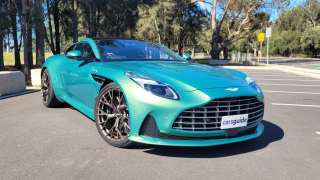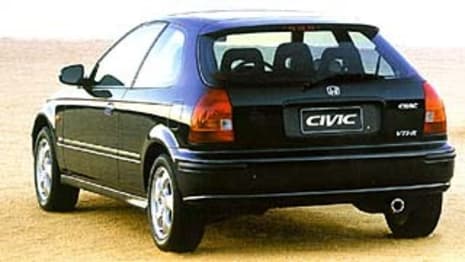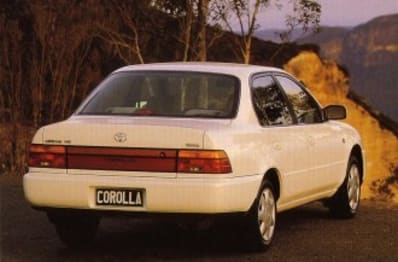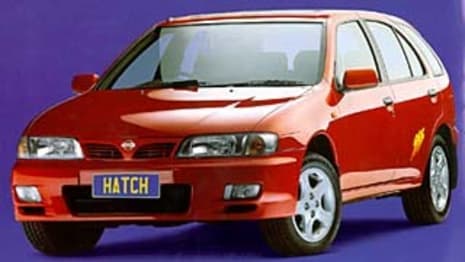
Used Honda Civic review: 1995-2000
- Honda Civic
- Honda Civic 2000
- Honda Civic 1995
- Honda Civic 1996
- Honda Civic 1997
- Honda Civic 1998
- Honda Civic 1999
- Honda Civic Reviews
- Honda Reviews
- Honda Hatchback Range
- Honda Sedan Range
- Honda Coupe Range
- Hatchback
- Sedan
- Coupe
- Honda
- Used Car Reviews

The Honda Civic offers small car buyers a little more than the rest; it also has a reputation for quality and design innovation that sets it apart in the eyes of small car buyers.
Each new generation offered an appealing blend of quality, style, packaging, performance and price, and the sixth generation that arrived here in 1995 was no different.
Models
The sixth gen Civic took Honda’s small car to a whole new level of quality, refinement and performance.
The fifth generation, while maintaining the things that made the Civic so appealing, was criticized for its packaging, road noise and ride, which left Honda with some ground to recover with the sixth gen.
Obviously stung by the criticism the company strove to answer it with the new model.
The style and build quality that was so well liked was carried through, but with much improved packaging and refinement. The road noise in particular was much lower that it was in the previous model.
There were three body styles in the sixth gen range, the Japanese-sourced three-door hatch and four-door sedan, and a two-door coupe that came from America.

All three were based on a modified version of the previous model sedan’s platform, which retained the sedan’s longer wheelbase.
The three-door hatch was offered in CXi, GLi and potent VTi-R models, the sedan in GLi and VTi variants, and the coupe was available as a GLi, VTi and VTi-R.
Standard equipment on the CXi hatch was a driver’s airbag, power mirrors, power steering and four-speaker sound with a radio-cassette player. Air conditioning was optional, but sadly it wasn’t climate control.
A minor update in 1998 saw it acquire square headlights, and remote central locking was added to the features list.
The GLi sedan and hatch were similarly equipped, but in addition had central locking and power windows standard.

Air conditioning was optional until 1997 when it became standard, and a passenger airbag was added in the 1998 update.
The sporty VTi-R hatch featured airbags for the driver and front seat passenger, ABS braking, 15-inch alloy wheels, power windows and mirrors, power steering and a power sunroof.
Likewise the VTi sedan had dual front airbags, ABS braking, central locking, power windows and mirrors, and radio-cassette player. Air conditioning became standard in 1997.

The coupe models boasted similar equipment to their sedan and hatch cousins.
Although it was quite well equipped for the era, the Civic lacked things like Bluetooth, so it wasn’t possible to sync an iPhone or Android device, it didn’t have a touch screen, and sat-nav wasn’t available.
There was nothing to assist the driver when parking, there were no parking sensors, no reversing camera, and it didn’t have a park assist system.
Cabin
Although it had the same wheelbase as the previous model, the sedan was 55mm longer, which was used to increase the legroom in the cabin.

Most of it was used to expand legroom in the rear seat, but a small amount went towards better front seat legroom.
The hatch now shared the same wheelbase as the sedan, which meant the wheelbase grew by 50 mm compared to the previous model. That resulted in more rear legroom and much needed passenger comfort. It was also higher and that also made it a more comfortable place to be.
Cupholders were provided for front seat occupants.
Engine
There was a choice of three 1.6-litre four-cylinder engines and all delivered better performance than those in the previous model.
They started with a single overhead camshaft unit in the CXi and GLi models that punched out 88kW (118 horsepower) at 6400rpm and 144Nm at 5000rpm at its respective power and torque peaks.

There was also a choice of two engines with Honda’s VTEC variable valve timing system.
One was a single overhead camshaft unit that gave similar performance to the base 1.6-litre, but was configured to work with Honda’s then new Continuously Variable Transmission (CVT) and optimize fuel consumption.
The other was the double overhead camshaft VTEC performance engine in the VTi-R that thumped out 118kW (158 horsepower) at 7600rpm and 148Nm at 7000rpm.

Notably, this engine delivered 100 horsepower per litre, a benchmark for engine performance.
All engines except the VTEC ran on regular 91-octane unleaded petrol, the VTEC required 95-octane premium unleaded.
Three transmissions were offered in the Civic, the CVT, a regular four-speed automatic transmission and a five-speed manual gearbox.
The CVT was available in the VTi, the auto in the CXi and GLi, and the manual in the CXi, GLi, VTi and VTi-R.
Driving
With decent power and torque all models were pleasant to drive with good performance and reasonably agile handling.
The VTi-R with its VTEC engine was the sporty choice; the engine revved freely into the upper regions of the rev range, and responded well to the urges of an enthusiastic driver.
All returned quite good fuel economy to go with the performance.
Safety
The list of safety features in the sixth gen Civic was a short one.
Driver airbags were standard across all models, but only the VTi and VTi-R sedans and hatches had a passenger airbag as well.
That changed in the 1998 update; all models then had dual front airbags.
But only the VTi and VTi-R had ABS anti-lock braking, the GLi and CXi didn’t.
It was also too early for ISOFIX baby car seat mounts.
The boot was a generous 351 litres in volume.
Any common issues?
The Civic has an admirable reliability record; little of a serious nature went wrong with them when they were in their prime.
That time has passed, so any problems that might occur now are most likely due to age, high kilometres, or poor maintenance.
The car to buy is the one that is in the best condition, with the lowest odometer reading, and the best service record.
Look for one that has been pampered by a caring owner, driven infrequently, and has credible evidence that it has seen the inside of a service shop as Honda recommended.
Regular oil changes are necessary to avoid the expensive build-up of sludge that can cause the demise of any engine, but Honda engines in particular.
Belts are used to drive the camshafts and these need to be changed every 100,000km or so.
Likewise the gearboxes, which stand up well, but the automatic likes the Honda-recommended oil. Straying from the Honda oil may save a few bucks, but it can lead to troubles down the road.
Bodywise, the Civic copes well. It’s a solid little car that generally stays rattle free as the kilometres climb.
Obviously, look closely for the telltale signs of a bingle; mismatched paint, sagging doors, boot lids or hatches.
The Civic interior also copes quite well with our harsh sun. The general fit and finish is of a high quality, the parts are durable, and the trim seems hard wearing.
Capped price servicing was still a thing of the future when the sixth gen Civic was launched, but service costs are not excessive and any competent mechanic can do it.
MORE: If anything crops up, you’ll probably find it on our Honda Civic problems page
Owners view
Marilyn Gardiner: I only intended to keep my 1999 Civic GLi sedan for three years, but it was so stylish and so reliable in 106,000 km that I kept it for much longer. It lacked the zip of the Astra I had before it, but it didn’t cost as much to run.
Geoff McDonald: I bought my CXi hatch new in 1997. Honda dealers regularly serviced it and the only expense I incurred other than filters and plugs was a replacement light bulb costing $5.00. The car is as good as new in terms of performance and fuel consumption, the body is perfect, and the paintwork is excellent.
Alvin Short: I’m still driving my 1997 Civic and it’s still going well. All I’ve had to do is service it and replace tyres. Its reliability is second to none.
Phil Dwyer: I bought my 1999 Civic in 2007. It has bags of room, the seats are very comfortable and the performance is quite good. It’s also been quite reliable for its age. I’ve had to fix a rattling in the steering column, and replace the clutch, exhaust and catalytic convertor.
Verdict
In good condition it’s a small car worth considering.
Have you owned a Honda Civic before? Share your experience in the comments.
Pricing
| Year | Price From | Price To |
|---|---|---|
| 2000 | $2,640 | $6,820 |
| 1999 | $2,640 | $6,820 |
| 1998 | $2,420 | $6,490 |
| 1997 | $2,420 | $6,490 |
| 1996 | $2,420 | $6,490 |
| 1995 | $2,420 | $6,490 |
Pricing guides
Range and Specs
| Vehicle | Specs | Price* | |
|---|---|---|---|
| Breeze | 1.5L, ULP, 5 SP MAN | $2,750 – 4,290 | 1995 Honda Civic 1995 Breeze Pricing and Specs |
| GLi | 1.6L, ULP, 5 SP MAN | $2,970 – 4,620 | 1995 Honda Civic 1995 GLi Pricing and Specs |
| GLi | 1.5L, ULP, 5 SP MAN | $2,640 – 4,070 | 1995 Honda Civic 1995 GLi Pricing and Specs |
| CXi | 1.6L, ULP, 4 SP AUTO | $2,860 – 4,400 | 1995 Honda Civic 1995 CXi Pricing and Specs |
Other cars to consider
$2,750
Lowest price, based on third party pricing data











